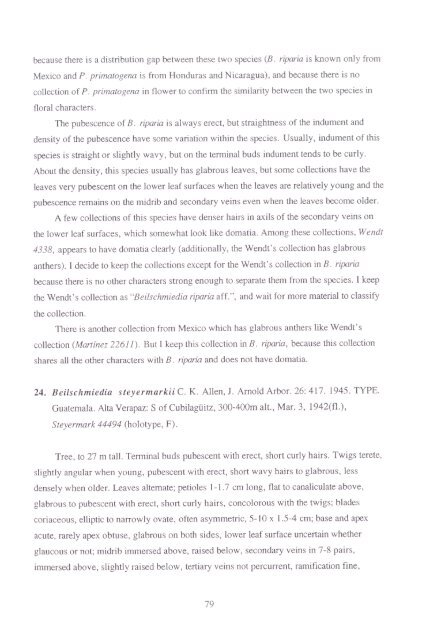Revisional study of neotropical Beilschmiedia species (Lauraceae ...
Revisional study of neotropical Beilschmiedia species (Lauraceae ...
Revisional study of neotropical Beilschmiedia species (Lauraceae ...
Create successful ePaper yourself
Turn your PDF publications into a flip-book with our unique Google optimized e-Paper software.
ecause there is a distribution gap between these two <strong>species</strong> (B. riparia is known only from<br />
Mexico and P. primatogena is from Honduras and Nicaragua), and because there is no<br />
collection <strong>of</strong> P. primatogena in flower to confirm the similarity between the two <strong>species</strong> in<br />
floral characters.<br />
The pubescence <strong>of</strong> B. riparia is always erect, but straightness <strong>of</strong> the indument and<br />
density <strong>of</strong> the pubescence have some variation within the <strong>species</strong>. Usually, indument <strong>of</strong> this<br />
<strong>species</strong> is straight or slightly wavy, but on the terminal buds indument tends to be curly.<br />
About the density, this <strong>species</strong> usually has glabrous leaves, but some collections have the<br />
leaves very pubescent on the lower leaf surfaces when the leaves are relatively young and the<br />
pubescence remains on the midrib and secondary veins even when the leaves becon1e older.<br />
A few collections <strong>of</strong> this <strong>species</strong> have denser hairs in axils <strong>of</strong> the secondary veins on<br />
the lower leaf surfaces, which somewhat look like domatia. Among these collections, Wendt<br />
4338, appears to have domatia clearly (additionally, the Wendt's collection has glabrous<br />
anthers). I decide to keep the collections except for the Wendt's collection in B. riparia<br />
because there is no other characters strong enough to separate them from the <strong>species</strong>. I keep<br />
the Wendt's collection as "<strong>Beilschmiedia</strong> riparia aff.", and wait for more material to classify<br />
the collection.<br />
There is another collection from Mexico which has glabrous anthers like Wendt's<br />
collection (Martfnez 22611). But I keep this collection in B. riparia, because this collection<br />
shares all the other characters with B. riparia and does not have domatia.<br />
24. Beilscluniedia steyermarkii C. K. Allen, J. Arnold Arbor. 26: 417. 1945. TYPE.<br />
Guatemala. Alta Verapaz: S <strong>of</strong> Cubilagtiitz, 300-400m alt., Mar. 3, 1942(fl.),<br />
Steyermark 44494 (holotype, F).<br />
Tree, to 27 m tall. Terminal buds pubescent with erect, short curly hairs. Twigs terete,<br />
slightly angular when young, pubescent with erect, short wavy hairs to glabrous, less<br />
densely when older. Leaves alternate; petioles 1-1.7 em long, flat to canaliculate above,<br />
glabrous to pubescent with erect, short curly hairs, concolorous with the twigs; blades<br />
coriaceous, elliptic to narrowly ovate, <strong>of</strong>ten asymmetric, 5-10 x 1.5-4 em; base and apex<br />
acute, rarely apex obtuse, glabrous on both sides, lower leaf surface uncertain whether<br />
glaucous or not; midrib imn1ersed above, raised below, secondary veins in 7-8 pairs,<br />
immersed above, slightly raised below, tertiary veins not percurrent, ramification fine,<br />
79
















